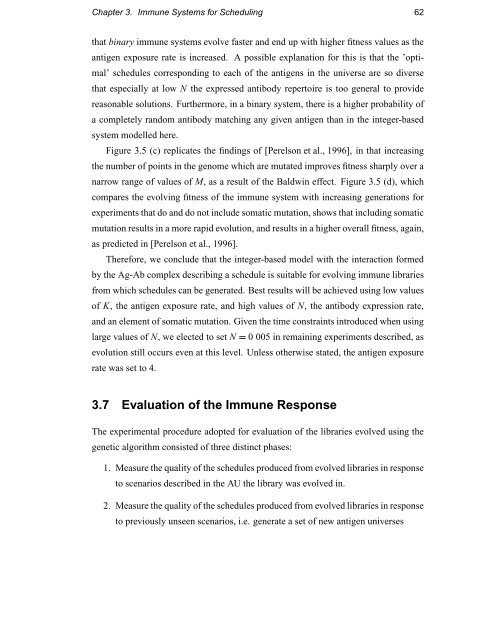Immunology as a Metaphor for Computational ... - Napier University
Immunology as a Metaphor for Computational ... - Napier University
Immunology as a Metaphor for Computational ... - Napier University
Create successful ePaper yourself
Turn your PDF publications into a flip-book with our unique Google optimized e-Paper software.
Chapter 3. Immune Systems <strong>for</strong> Scheduling 62that binary immune systems evolve f<strong>as</strong>ter and end up with higher fitness values <strong>as</strong> theantigen exposure rate is incre<strong>as</strong>ed. A possible explanation <strong>for</strong> this is that the ’optimal’schedules corresponding to each of the antigens in the universe are so diversethat especially at low N the expressed antibody repertoire is too general to providere<strong>as</strong>onable solutions. Furthermore, in a binary system, there is a higher probability ofa completely random antibody matching any given antigen than in the integer-b<strong>as</strong>edsystem modelled here.Figure 3.5 (c) replicates the findings of [Perelson et al., 1996], in that incre<strong>as</strong>ingthe number of points in the genome which are mutated improves fitness sharply over anarrow range of values of M, <strong>as</strong> a result of the Baldwin effect. Figure 3.5 (d), whichcompares the evolving fitness of the immune system with incre<strong>as</strong>ing generations <strong>for</strong>experiments that do and do not include somatic mutation, shows that including somaticmutation results in a more rapid evolution, and results in a higher overall fitness, again,<strong>as</strong> predicted in [Perelson et al., 1996].There<strong>for</strong>e, we conclude that the integer-b<strong>as</strong>ed model with the interaction <strong>for</strong>medby the Ag-Ab complex describing a schedule is suitable <strong>for</strong> evolving immune librariesfrom which schedules can be generated. Best results will be achieved using low valuesof K, the antigen exposure rate, and high values of N, the antibody expression rate,and an element of somatic mutation. Given the time constraints introduced when usinglarge values of N, we elected to set N 0¦ 005 in remaining experiments described, <strong>as</strong>evolution still occurs even at this level. Unless otherwise stated, the antigen exposurerate w<strong>as</strong> set to 4.3.7 Evaluation of the Immune ResponseThe experimental procedure adopted <strong>for</strong> evaluation of the libraries evolved using thegenetic algorithm consisted of three distinct ph<strong>as</strong>es:1. Me<strong>as</strong>ure the quality of the schedules produced from evolved libraries in responseto scenarios described in the AU the library w<strong>as</strong> evolved in.2. Me<strong>as</strong>ure the quality of the schedules produced from evolved libraries in responseto previously unseen scenarios, i.e. generate a set of new antigen universes









![Unit 5. Switches and VLANs [PDF]](https://img.yumpu.com/34422504/1/184x260/unit-5-switches-and-vlans-pdf.jpg?quality=85)






